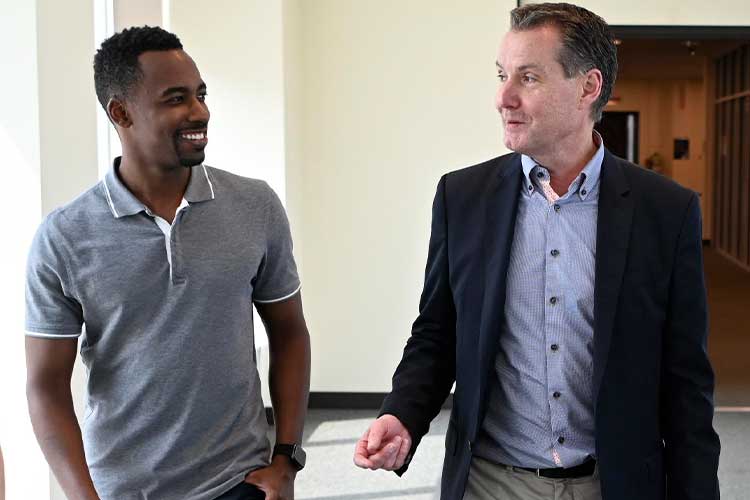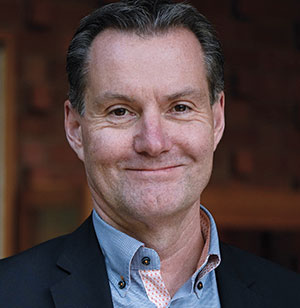The 2023 CEOs Who “Get It”

Anders Sjoelin
President and CEO
S&C Electric Co.
Chicago, IL

In 1909, S&C Electric Co. transformed the delivery of safe, reliable electricity with the invention of the Liquid Power Fuse. Today, as the world faces extreme weather events and the demand for electricity grows, S&C and its 3,500 employees continue to innovate and modernize the electrical grid, ensuring reliable and resilient power for homes, communities, and critical infrastructure around the world.
Describe your personal journey to becoming a CEO who “gets it.” What experiences or lessons brought you to where you are now?

I grew up in Sweden in a time when the country was really emphasizing car safety. Many know the Swedish car brand Volvo as one of the safest automobiles on the market. But what many do not know is that Sweden was one of the first countries to regulate front- and back-passenger-seat belt use. So, I feel that a safety mindset, and certainly a car safety mindset, was instilled in me at an early age.
I worked many years in factory settings before I transitioned to leading businesses, including those with remote construction sites. This is where it connected with me how important team member engagement is to safety performance and culture. With so much going on in these different environments, you really depended on everyone doing the right thing every day. I really began to see that safety is truly a team sport. You need everyone to participate and do their best to take care of themselves and their team members, every minute of every day.
I also had the privilege of working with an inspirational safety leader who taught me the value of building an engaging safety culture. From this, I have built my own safety values – leading with passion, working more with leading indicators, focusing on preventive actions and personal engagement, and reinforcing communication. These values support my vision that all incidents are preventable. If people believe that you care, you can make a difference.
What is the biggest obstacle to safety at your organization, and how do you work to overcome it?
There is no one big obstacle. Safety is complex. It is every day and every minute. You need to build a safety culture from the ground up. You can’t push it down from the top. I focus on building on our safety culture by emphasizing leading indicators, team member engagement and everyone knowing that I care about our team members’ safety.
Making sure that our team members are trained, that they have the right tools and that they feel empowered to speak up is extremely important. Ensuring a safe working environment is an ongoing activity that requires the daily attention and efforts of everyone.
Why is safety a core value at your organization?
Safety should be a core value at any organization, and it is fundamental at S&C. It is engrained in every aspect of our business around the world. S&C is an employee-owned company, and everyone feels ownership over their environment and is empowered to act. As I said, safety is a team sport, and it is everyone’s responsibility.
In fact, S&C’s commitment to safety was one of the aspects of the culture I was most excited to explore when I became CEO. Caring for our team members and our customers has long been at the core of the S&C culture, guiding the decisions S&C leaders make and extending the daily actions our team members take to help keep their co-workers and themselves safe and healthy.
I started at S&C at the onset of the COVID-19 pandemic, and S&C’s culture of safety proved essential in our response to keep our employees safe and continue to serve our customers with excellence. This also gave me the opportunity to share my passion for safety and prepared me to address COVID-19 with the urgency needed to keep our team members safe and the business running to serve our customers.
I am humbled that my team nominated me for this award. But as I said earlier, safety is a team sport. I genuinely believe this. My role is making sure that, when it comes to safety, everyone knows that it is my No. 1 value and something that we must always be vigilant about.
How do you instill a sense of safety in employees on an ongoing basis?
A sense of safety is not enough. We need to build a culture of safety, and there are no shortcuts when it comes to safety. It is important for everyone to understand that safety is a core value and that we care about their well-being. One way we help our team members understand this is through communication and leadership engagement. Every meeting, at all levels of the organization, starts with a safety moment. This reminds people that safety is an “every day, every minute” effort. We must lead by example because we want to show that, when we care, we can make a difference, and nobody gets hurt.
How does your organization measure safety? What are the leading indicators that show you how safe your organization is, and where do you see room for improvement?
As mentioned earlier, I learned early in my career the importance of leading indicators and fostering a culture of engagement. To that end, participation in our safety programs is one of the leading indicators we track. We measure this monthly based on completed HSE activities. We also track near-miss reports, quick safety fixes, behavioral-based observations and hazard identification reports.
Additionally, we leverage leadership “go and sees” in the production area to observe operations and identify potential concerns. It reflects the importance of safety to our team members and gives them an opportunity to engage and share their feedback. Across our sites, we have also established a common classification of safety data for better analytics. This helps us turn data into insight and action faster.
As for how we can improve, this is a continuous process. For example, we hire hundreds of new team members every year. So, we always need to reinforce the vision that all incidents are preventable. Safety is behavioral, and we need to make sure that safe behaviors are modeled at every level of the organization and that everyone is engaged. As I said, safety is a team sport – everyone must be engaged and feel empowered that if they see something, they say something.
What role does off-the-job safety play in your organization’s overall safety program? What types of off-the-job safety and health programs does your organization offer to employees?
Health and safety go together – they are an integral part of our everyday lives. Many of our programs and initiatives have components that are easily transferable to off-the-job safety. One good example is our pre-work warmup exercises and industrial athlete programs that stress the importance of being physically ready for the task at hand. We also conduct “winter safety,” “summer heat stress” and “slip/trip/fall” programs that include at-home safety recommendations.
As mentioned earlier, we start every meeting with a safety moment. Many of our safety moments include advice around home safety, including fire prevention and cybersecurity. We also offer active training around distracted and defensive driving and car safety, as well as how to keep your mind on tasks.
What have you done to support employee mental health and well-being within your organization?
Mental health must be woven into any discussion around safety. Addressing the stigma related to mental health is key to fostering an environment where team members feel safe to bring their whole selves to work. Our approach was – and remains – to encourage team members to lead with empathy, both for themselves and each other. For example, we knew that COVID-19 fatigue was a real concern, and social justice issues impacted the well-being of many of our team members. We encouraged open discussions around mental health, starting at our quarterly leadership meetings and in my internal communications to team members.
In addition, we directed people to the many resources available to them, including our employee assistance program, which offers free, confidential counseling for team members and their families; our AMP-UP wellness program; and our affinity groups programming.
These programs help our team members better manage their personal wellness, enhance their total well-being and reinforce a safety-first culture throughout the organization. Team members are the heart of S&C, and our passion for safety is rooted in our belief that everyone is essential and what we do matters. Safety is a team sport, and we win when everyone plays as a team.
Post a comment to this article
Safety+Health welcomes comments that promote respectful dialogue. Please stay on topic. Comments that contain personal attacks, profanity or abusive language – or those aggressively promoting products or services – will be removed. We reserve the right to determine which comments violate our comment policy. (Anonymous comments are welcome; merely skip the “name” field in the comment box. An email address is required but will not be included with your comment.)


